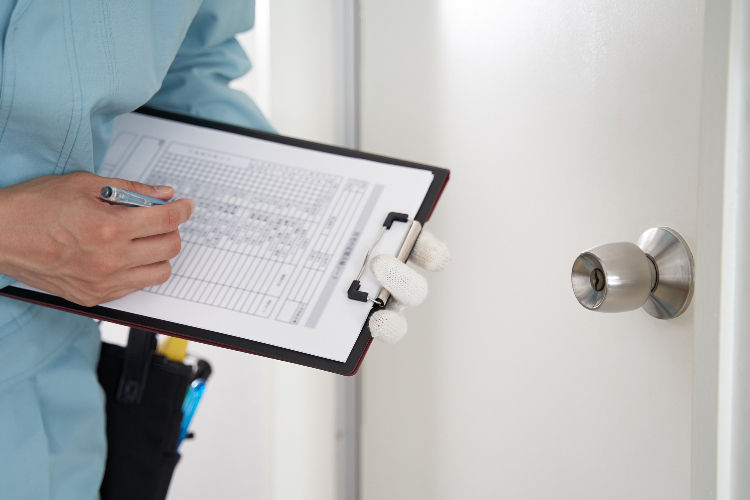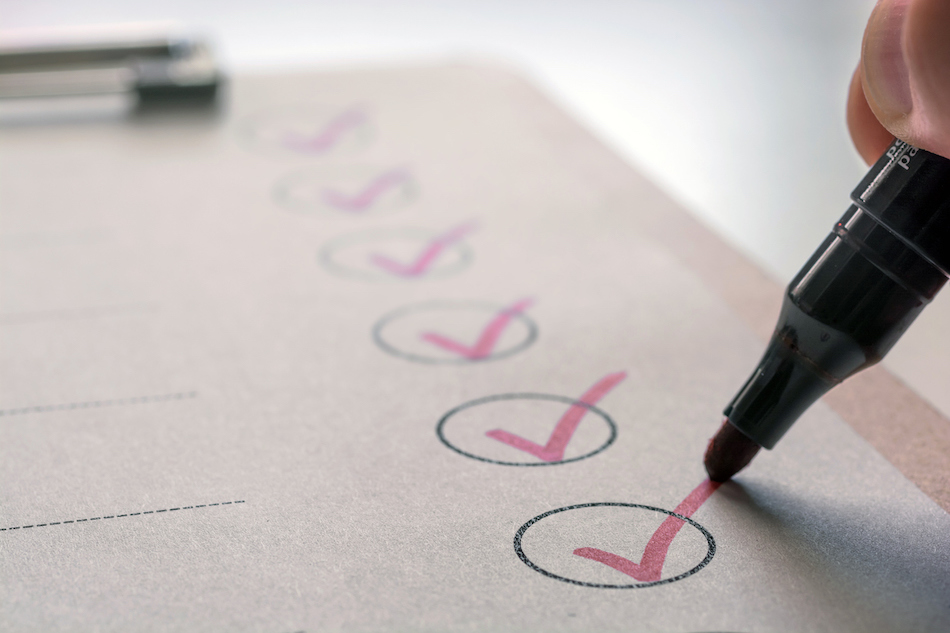Similar to the way that pilots use a preflight checklist prior to takeoff, real estate investors use a landlord checklist as a guide for managing a rental property through all stages of the tenant cycle.
Keep reading to learn how a landlord checklist works, and what to include when putting together a landlord checklist for rental property.
Key Takeaways
- A landlord checklist is used to document the condition of a rental property when an old tenant moves out and a new tenant moves in.
- In addition to documenting property condition, a landlord checklist can also be used through all stages of the tenant life cycle.
- Landlord checklists may include sections for leasing, signing a new lease, making the property rent ready, and managing the tenant during the time the home is occupied.
What is a landlord checklist?
A landlord checklist – also known as a new tenant checklist or a move-in checklist – helps a landlord to stay organized when the old tenant moves out and the new tenant moves in.
The landlord checklist is a form that includes a series of items a landlord or property manager “checks” to assess the current condition of the home.
For example, there may be damage other than normal wear and tear caused by the tenant vacating the property that might justify keeping part of all of the tenant’s security deposit to pay for abnormal damage (if allowed by state landlord-tenant laws).
A landlord checklist identifies items that may be in need of repair or replacement prior to the new tenant moving in, such as a slow water leak under the kitchen sink, burnt out light bulbs, or dirty air filters in the HVAC (heating, ventilation, and air conditioning) system.
Just as importantly, the landlord checklist documents the current condition of the rental property when the new tenant takes possession, and is compared to the move-out checklist done when the tenant eventually moves out of the property.
Ideally, the landlord checklist is completed by the landlord or property manager in the presence of the tenant. Once filled out, the landlord checklist is signed by both parties and is placed in the tenant file.
Benefits for landlords
- Helps to pinpoint any damage caused by the current tenant above and beyond normal wear and tear.
- Provides evidence to show why part or all of the tenant security deposit is not returned to help minimize the likelihood of a landlord-tenant dispute.
- Identifies items that need to be repaired or replaced before the new tenant moves in or during the term of the lease.
- Documents the condition of the property when the new tenant moves in, such as current wear and tear or pre existing damage.
Benefits for tenants
- Demonstrates to the tenant that the landlord is being fair and objective about the current condition of the property.
- Documents the current wear and tear of the home so that the tenant’s security deposit is not unreasonably withheld.
- Spotlights items that need to be repaired to ensure the tenant has a home that is in safe and habitable condition.
- Provides the opportunity for the landlord to explain to the tenant how home features work, such as a smart thermostat, security system, or automatic garage door opener.

Landlord checklist from start to finish
In addition to documenting the current condition of the rental property, a landlord checklist can also serve as a master guide that shows what needs to be done from through all stages of the tenancy cycle:
1. Lease a vacant property
The search for a new tenant begins even before the current tenant moves out. Having a new tenant lined up and ready to move in reduces the amount of potential rental income lost due to vacancy.
Items to include on the leasing section of the landlord checklist include:
- Advertising the property on an online rental listing service, promoting on social media, and word of mouth advertising by letting the neighbors know the home is available for rent.
- Utilizing online application forms to collect important information such as the names of all prospective tenants, their identification, employment history and references, and whether or not the tenant has pets.
- Running a credit report and background check to uncover items, such as current debt levels (used to analyze the tenant’s rent-to-income ratio), late payment and collections history, criminal history, and eviction history.
2. Execute a new lease
Executing a lease with a new tenant involves more than simply signing on the dotted line. As part of the lease signing process, landlords:
- Review the terms and conditions of the lease, along with the responsibilities of both parties, with the tenant because sometimes renters are so excited to move in that they don’t take the time to read the lease.
- Consider having the tenant sign or initial key parts of the lease agreement, such as the amount of the monthly rent, when the payment is due, any additional rent such as for a pet, late fees, security deposit, and total amount of money needed to move in, including pro rated rent.
- Execute the lease by having every adult tenant sign, along with the landlord or property manager, and ensure that each party receives a fully signed copy of the lease agreement.
- Set up rent payment methods, such as a direct account transfer, PayPal, or an online rent collection service, that automate rent collection and late fees.
- Send the new tenant a welcome letter verifying the move-in date, contact information for utilities, and highlights such as nearby shopping, schools, and entertainment.
Online rental listing websites such as Apartments.com and Zillow Rental Manager include leasing templates or allow landlords to create a rental lease online. Other sources to download a state-specific residential lease agreement include SparkRental and ezLandlordForms.
3. Make the property move-in ready
Note: if the property is in need of heavier repair or renovation, this could move up to be the first step before marketing it.
The landlord checklist that was completed when the previous tenant moved out serves as a guide to identify what needs to be done before the new tenant moves in. While every rental property is different, some of the general items to check to make a vacant property move-in ready include:
Keys & locks
- Collect all copies of keys and garage door openers from the previous tenant.
- Rekey all door locks.
- Verify all windows have security locks and screens.
- Reprogram the security system (if applicable).
- Reprogram the garage door opener (if applicable).
Basic items
- Walls, floors, and ceilings inspected for blemishes such as marks or scratches, repainting if necessary.
- Doors and windows checked for proper operation.
- Window coverings inspected for any needed repairs, cleaning, or replacement.
- Light fixtures checked for proper operation and light bulbs.
- Plumbing inspection to verify that there are no line clogs or minor leaks that could cause mold growth, and that the water heater or boiler is working correctly.
- Heating and cooling system inspected for proper operation, including replacing air filters and pre-scheduling seasonal maintenance.
- Stairs and hallways inspected for signs of damage, including stains or loose steps.
- Smoke detectors and fire alarms verified for proper operation, with batteries replaced if needed.
- Fire extinguishers should be fully charged and replaced if they have been used.
Interior items
- Appliances verified in proper working order, including stoves and burners, controls, range hood and ventilation, oven, refrigerator, dishwasher, microwave, and garbage disposal.
- Counters, drawers, cabinets, and closets checked for cleanliness and proper operation.
- Showers, bathtubs, and toilets checked for cleanliness and condition, such as cracks or missing grout, well-functioning water drains, and knobs or controls.
- Baseboards and moldings checked for damage and cleanliness.
- Carpets and floorings professionally cleaned, with any tears or cracks repaired to help ensure the safety of the tenant.
- Fireplace (if applicable) should be professionally cleaned of any soot or debris, and checked for damage caused by rodents or animals.
Exterior items
- Driveway and front walk to home inspected for chips or cracks, and any oil or grease stains removed.
- Landscaping trimmed back, existing in-ground watering systems checked for breaks or leaks, and gutters cleaned to help prevent damage to the roof, exterior walls, or foundation of the home.
- Patios, porches, decks, and balconies inspected for damage, cracks, or breakage.
4. Conduct a tenant move-in walk-through
After the lease has been signed and repairs have been made, schedule a time to meet the tenant and complete the move-in part of the landlord checklist. Items contained in the move-in part of the landlord checklist include:
- Verify all paperwork has been signed.
- Review the terms and conditions of the lease with the tenant one last time.
- Ensure that all rent required to move in – such as the first month, security deposit, and pro-rated rent if the tenant is moving in before the 1st of the month – has been collected.
- Check that the tenant has obtained renters insurance if required in the lease (and allowed by state landlord-tenant laws).
- Walk-through the home with the tenant and complete a move-in checklist to identify any open items in need of repair, and to verify the condition of the property when the tenant takes possession.
- Provide the tenant with a copy of the move-in checklist signed by the landlord or property manager and all adult tenants, and give the tenant the keys and any remote controls (such as the garage door opener or ceiling fan controls).
5. Manage the tenant lease
Proper tenant lease management includes maintaining open lines of communication with the tenant, collecting the monthly rent, maintaining the property and making any needed repairs, and complying with local and state landlord-tenant and fair housing laws.
Steps to manage the tenant throughout the entire term of the lease include:
- Enforcing rent payment due dates and assessing late fees when applicable.
- Making it easy for the tenant to pay rent by using an online rent payment system.
- Responding to maintenance issues and making repairs promptly.
- Conducting periodic inspections of the interior and exterior of the home, being sure to give the tenant proper notice before entering the property.
- Informing the tenant in advance of any routine maintenance, such as gutter cleaning, pest control, and semi-annual servicing of the heating and air conditioning systems.
- Contacting the tenant about renewing the lease several months in advance of the expiration date, explaining any rental increase, and considering to offer an incentive to the tenant for signing a new lease (such as professional carpet cleaning or a gift certificate).
6. Move the current tenant out
The day will eventually come when the tenant decides to move out. The landlord checklist is used for a tenant move-out similar to when the tenant first moved in:
- Scheduling a day and time to conduct a move-out inspection.
- Using the move-in checklist as a guide, identifying items that need to be repaired or replaced due to normal wear and tear, along with any excessive damage caused by the tenant.
- Explaining to the tenant if any part of the refundable security deposit is being withheld to pay for excessive damage, if allowed by local and state landlord-tenant laws.
- Verifying the tenant’s new mailing address for return of the security deposit.
- Ensuring that all keys and remote controls are returned by the tenant moving out.
- Providing the tenant with a copy of the move-out checklist signed by the landlord and the tenant.
- Immediately contacting vendors to make any needed repairs so that the new tenant can move in as quickly as possible.

Where to find a landlord checklist template
A real estate attorney or property manager are two good sources for finding a landlord checklist that complies with state landlord-tenant laws. Some online resources for downloading a free landlord checklist include:
Most documents can be downloaded in a PDF and Word version so that the landlord checklist can be customized to meet the specific needs of each owner and rental property.









